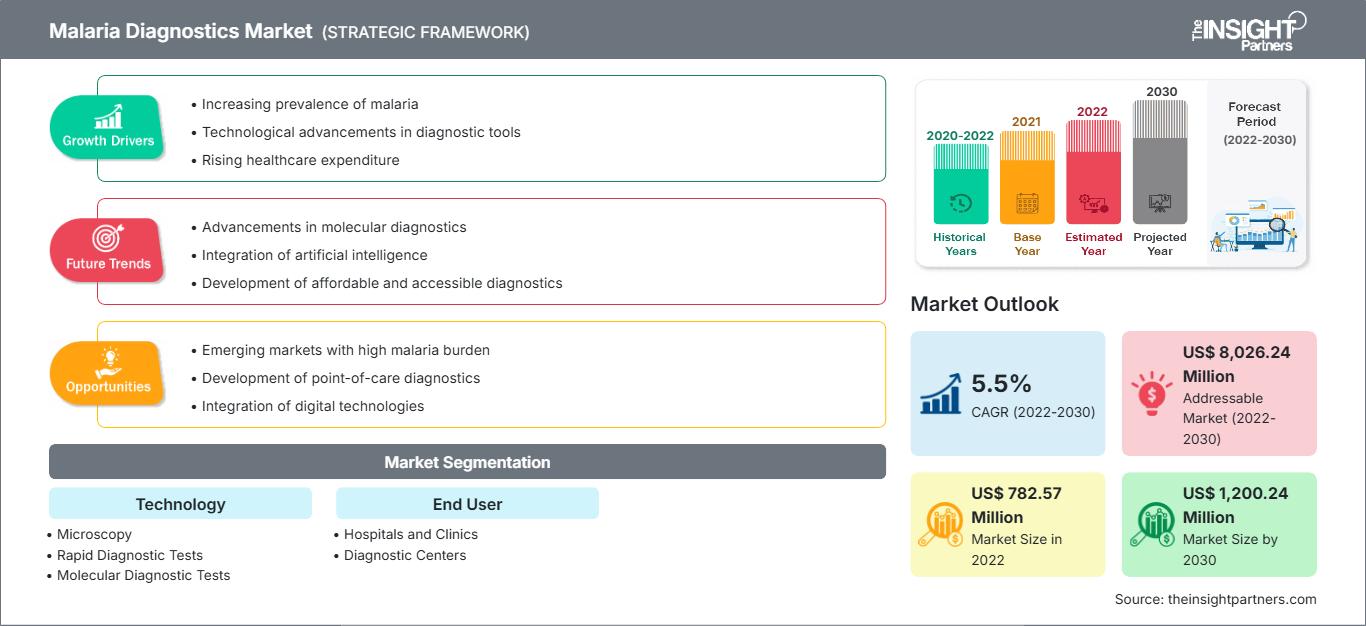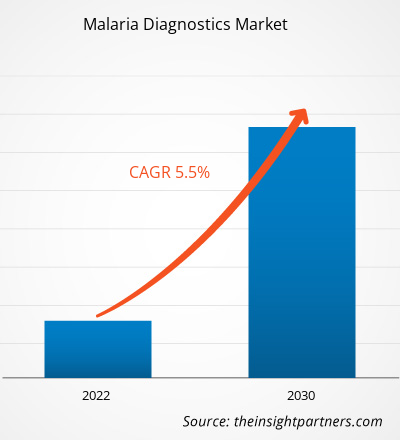[연구 보고서] 말라리아 진단 시장 규모는 2022년 7억 8,257만 달러에서 2030년 12억 24만 달러로 성장할 것으로 예상되며, 2022년부터 2030년까지 연평균 성장률 5.5%를 기록할 것으로 예상됩니다.
시장 분석 및 분석가 보기:
말라리아는 말라리아 원충(Plasmodium pore)에 의해 발생하는 생명을 위협하는 질병입니다. 저소득 국가에서 말라리아 발생률이 높고 국제 및 국가 기관에서 전 세계적으로 말라리아 퇴치 프로그램을 시행함에 따라 말라리아 진단 시장이 성장하고 있습니다. 첨단 진단 도구 출시 증가와 효과적인 치료법 연구 활동 증가는 시장 성장에 더욱 기여하고 있습니다.
COVID-19 팬데믹 이전에는 풍토병 발생 국가의 거의 3분의 1이 국제적인 목표를 향해 나아가고 있었습니다. 발병률이 낮은 많은 국가들은 2025년까지 말라리아를 잠재적으로 근절하기 위해 노력하는 25개국으로 구성된 세계보건기구(WHO)의 "2025년 말라리아 퇴치 이니셔티브(Elimination 2025 Initiative)"에 참여했습니다. 반면, 약 3분의 1의 국가에서는 진전이 정체되었고, 다른 국가에서는 말라리아 발병률이 증가했습니다. 질병 부담이 큰 국가들은 말라리아 퇴치 시도에서 검사와 선별 검사의 중요성이 여전히 높음에도 불구하고, 진단 검사 데이터를 활용하여 지역적으로 적합한 개입을 계층화하고 집중하는 경향을 보이고 있습니다.
COVID-19 팬데믹 첫해에는 사례 관리 및 예방 노력의 경미한 차질로 인해 말라리아 발생 사례와 사망자가 증가했습니다. 그럼에도 불구하고, WHO, 국가 말라리아 프로그램, 그리고 파트너 기관들의 협력으로 말라리아 사망자가 두 배로 증가하는 최악의 시나리오는 피할 수 있었습니다. 필요한 말라리아 물자 확보의 어려움과 팬데믹이 말라리아 관리 조치에 궁극적으로 어떤 영향을 미쳤는지에 대한 불확실한 양상이 있었습니다.
성장 동력:
급성 열성 질환 중 하나인 말라리아는 플라스모디움 기생충에 의해 발생하며 감염된 암컷 아노펠레스 모기를 통해 전파됩니다. 인간의 말라리아를 유발하는 기생충은 다섯 종으로, 그중 플라스모디움 팔시파룸(Plasmodium falciparum)과 삼일열원충(P. vivax) 두 종이 가장 큰 위협으로 간주됩니다. 또한, 열대열원충은 가장 치명적인 말라리아 기생충으로 아프리카 대륙에 가장 널리 분포되어 있습니다. 또한, 삼일열원충(P. vivax)은 사하라 이남 아프리카 국가를 제외한 대부분의 국가에서 주요 말라리아 기생충입니다. 세계보건기구(WHO)의 2020년 세계 말라리아 보고서(WMR)에 따르면, 전 세계적으로 2억 4,100만 건의 말라리아 사례가 보고되었으며, 이는 2019년 2억 2,700만 건에 비해 증가한 수치입니다. 같은 자료에 따르면, 말라리아로 인한 사망자 수는 매년 6만 9천 명씩 증가하고 있습니다. 이 중 약 3분의 2인 4만 7천 명은 COVID-19 팬데믹 기간 동안 의료 서비스 중단으로 인해 발생했습니다. 나머지 3분의 1인 22,000명의 사망자는 WHO의 말라리아 사망률 계산 방법론(COVID-19 중단과 무관)의 최근 변경을 반영합니다.
2020년 말라리아로 인한 전 세계 사례의 약 95%와 사망자의 약 96%가 WHO 아프리카 지역에서 보고되었으며, 보고된 총 사망자의 약 80%가 5세 이하 어린이였습니다. WMR 2021에 따르면, 전 세계 말라리아 부담의 약 2%가 동남아시아 국가에서 기록되었으며, 이 중 인도는 2020년 추정 말라리아 사례의 83%와 이 질병과 관련된 사망자의 82%를 차지했습니다. 따라서 전 세계 여러 지역에서 말라리아 유병률이 증가함에 따라 말라리아 진단 시장의 성장이 촉진됩니다.
Pf가 아닌 mRDT인 WHO 사전 적격성 평가 제품은 제한된 수로 시장에 출시되어 있습니다. WHO 사전적격성평가(PRQ)를 받은 다양한 mRDT 제품이 공급되고 있음에도 불구하고, 수요는 특정 제품 및 제조업체의 선호도에 따라 편중되어 있습니다. 이로 인해 시장의 공급 다양성, 보안성, 그리고 생산 능력을 확보하는 데 제약이 발생합니다. 이에 따라 제조업체들은 일부 국가의 제품 수요 감소, 대체 제품 도입에 대한 소극적 태도 및 관심 부족 등의 어려움에 직면하게 됩니다. 대체 브랜드 도입은 국가별 알고리즘에 따라 선택된 브랜드를 변경하거나 비용 부담으로 인해 발생할 수 있습니다.
요구 사항에 맞게 이 보고서를 사용자 정의하십시오.
이 보고서의 일부, 국가 수준 분석, Excel 데이터 팩을 포함하여 모든 보고서에 대한 사용자 정의를 무료로 받을 수 있을 뿐만 아니라 스타트업 및 대학을 위한 훌륭한 제안 및 할인을 이용할 수 있습니다
말라리아 진단 시장: 전략적 통찰력

-
이 보고서의 주요 주요 시장 동향을 확인하세요.이 무료 샘플에는 시장 동향부터 추정 및 예측에 이르기까지 데이터 분석이 포함됩니다.
보고서 세분화 및 범위:
“말라리아 진단 시장”은 기술 및 최종 사용자를 기준으로 세분화됩니다. 말라리아 진단 시장은 기술별로 현미경 검사, 신속 진단 검사(RDT), 분자 진단 검사로 구분됩니다. 신속 진단 검사(RDT) 부문은 2022년에 가장 큰 시장 점유율을 기록했으며, 2022년부터 2030년까지 시장에서 가장 높은 연평균 성장률(CAGR)을 기록할 것으로 예상됩니다. 말라리아 진단 시장은 최종 사용자별로 병원 및 진료소, 진단 센터 등으로 구분됩니다. 병원 및 진료소 부문은 2022년에 가장 큰 시장 점유율을 기록했습니다. 진단 센터 부문은 2022년부터 2030년까지 시장에서 가장 높은 연평균 성장률(CAGR)을 기록할 것으로 예상됩니다.
부문별 분석:
말라리아 진단 시장은 기술별로 현미경 검사, 신속 진단 검사(RDT), 분자 진단 검사로 구분됩니다.
신속 진단 검사(RDT) 부문은 2022년에 시장 점유율이 가장 높았으며, 2022년부터 2030년까지 시장에서 가장 높은 연평균 성장률을 기록할 것으로 예상됩니다. 말라리아 신속 진단 검사(RDT)는 사람 혈액에서 말라리아 기생충의 존재를 확인함으로써 말라리아 진단에 도움을 줍니다. RDT는 특히 고품질 현미경 검사 서비스에 대한 접근성이 제한적인 상황에서 임상 기반 진단이나 현미경 검사의 대안을 제공합니다. 일부 RDT는 열대열말라리아(Plasmodium falciparum, P. vivax)만 식별할 수 있지만, 다른 RDT는 열대열말라리아, 삼일열말라리아, 말라리아 원충(P. malariae, P. ovale)의 네 가지 종을 식별할 수 있습니다. 일반적으로 검사를 위해 혈액을 채취하는 데 손가락 끝을 찔러 채혈합니다.
말라리아 진단 시장은 최종 사용자 기준으로 병원 및 진료소, 진단 센터, 기타로 구분됩니다. 병원 및 진료소는 전 세계적으로 환자 수가 증가함에 따라 눈에 띄게 발전하고 있습니다. 이들은 저렴한 환경에서 매우 효과적인 치료를 제공합니다. 빠른 처리 시간, 저렴한 비용, 편리한 접근성을 갖춘 RDT 사용에 대한 중요성이 점점 커지고 있는 것은 말라리아 진단 시장에서 진료소가 우위를 점하는 주요 원인 중 하나입니다.
지역 분석:
글로벌 말라리아 진단 시장은 북미, 유럽, 아시아 태평양, 남미 및 남미 지역으로 지리적으로 구분됩니다. 중앙아메리카, 중동 및 아프리카. 미국과 같은 선진국의 투자 증가, 환자 수 증가, 그리고 세계보건기구(WHO)가 아프리카 국가의 말라리아 사망률 감소에 더욱 집중함에 따라 중동 및 아프리카 지역은 예측 기간 동안 시장 지배력을 유지할 것으로 예상됩니다. WHO가 2022년 7월에 발표한 자료에 따르면, 사하라 이남 아프리카 지역이 말라리아 발병 건수의 약 95%, 사망자의 96%를 차지할 것으로 예상됩니다.
말라리아 진단 시장The Insight Partners의 분석가들은 예측 기간 동안 말라리아 진단 시장에 영향을 미치는 지역별 동향과 요인을 면밀히 분석했습니다. 이 섹션에서는 북미, 유럽, 아시아 태평양, 중동 및 아프리카, 그리고 중남미 지역의 말라리아 진단 시장 부문과 지역별 현황도 살펴봅니다.
말라리아 진단 시장 보고서 범위
| 보고서 속성 | 세부 |
|---|---|
| 시장 규모 2022 | US$ 782.57 Million |
| 시장규모별 2030 | US$ 1,200.24 Million |
| 글로벌 CAGR (2022 - 2030) | 5.5% |
| 이전 데이터 | 2020-2022 |
| 예측 기간 | 2022-2030 |
| 다루는 세그먼트 |
By 기술
|
| 포함된 지역 및 국가 |
북미
|
| 시장 선도 기업 및 주요 회사 프로필 |
|
말라리아 진단 시장 참여자 밀도: 비즈니스 역학에 미치는 영향 이해
말라리아 진단 시장은 소비자 선호도 변화, 기술 발전, 그리고 제품 효능에 대한 인식 제고 등의 요인으로 인한 최종 사용자 수요 증가에 힘입어 빠르게 성장하고 있습니다. 수요가 증가함에 따라 기업들은 제품 라인업을 확장하고, 소비자 니즈를 충족하기 위한 혁신을 추진하며, 새로운 트렌드를 적극 활용하고 있으며, 이는 시장 성장을 더욱 가속화하고 있습니다.

- 을 얻으세요 말라리아 진단 시장 주요 주요 플레이어 개요
산업 발전 및 미래 기회:
말라리아 진단 시장에서 활동하는 주요 기업들의 다양한 전략적 개발 내용은 다음과 같습니다.
- 2022년 2월, 케냐 의학연구소(KEMRI)는 말라리아 검사용 플라스모첵(Plasmochek)을 출시했습니다. 플라스모첵은 말라리아를 유발하는 기생충인 플라스모디움(Plasmodium)을 검출하도록 설계되었습니다. 이 키트는 열대열원충(Plasmodium falciparum) 히스티딘 풍부 단백질 II와 열대열원충 젖산탈수소효소(Plasmodium lactate dehydrogenase)에 특이적인 항체를 활용하여 말라리아 감염을 검출합니다.
- 2019년 12월, Access Bio와 Global Good(Access Bio의 협력 파트너)는 기존 uRDT보다 히스티딘 풍부 단백질 2(HRP2) 항원을 5배 더 민감하게 식별하는 새로운 초고감도 신속 진단 검사(uRDT)를 개발했습니다. 또한, 말라리아 진단을 개선하기 위한 다양한 도구가 개발되었습니다.
경쟁 환경 및 주요 회사:
Access Bio., Inc.; Abbott Laboratories; Premier Medical Corporation Pvt. Ltd.; Sysmex Partec GmbH; bioMerieux; Beckman Coulter Inc.; Siemens Healthineers; Leica Microsystems GmbH; Nikon Corporation; Olympus Corporation; Bio-Rad Laboratories Inc.는 말라리아 진단 시장의 주요 기업입니다. 이 회사들은 전 세계적으로 증가하는 소비자 수요를 충족하기 위해 신기술 개발, 기존 제품 업그레이드, 그리고 지역 확장에 집중하고 있습니다.
- 과거 분석(2년), 기준 연도, CAGR을 포함한 예측(7년)
- PEST 및 SWOT 분석
- 시장 규모 가치/거래량 - 글로벌, 지역, 국가
- 산업 및 경쟁 환경
- Excel 데이터세트
최근 보고서
사용 후기
구매 이유
- 정보에 기반한 의사 결정
- 시장 역학 이해
- 경쟁 분석
- 고객 인사이트
- 시장 예측
- 위험 완화
- 전략 기획
- 투자 타당성 분석
- 신흥 시장 파악
- 마케팅 전략 강화
- 운영 효율성 향상
- 규제 동향에 발맞춰 대응






















 무료 샘플 받기 - 말라리아 진단 시장
무료 샘플 받기 - 말라리아 진단 시장